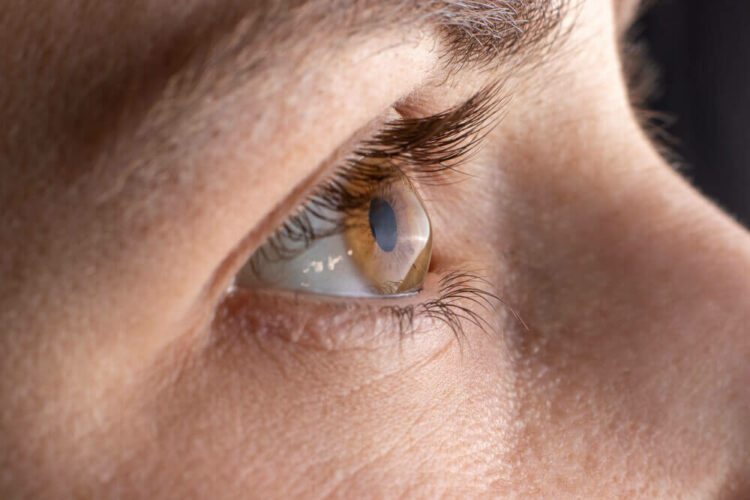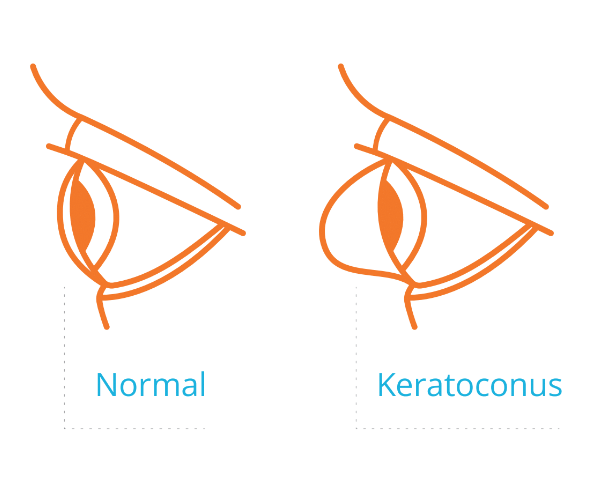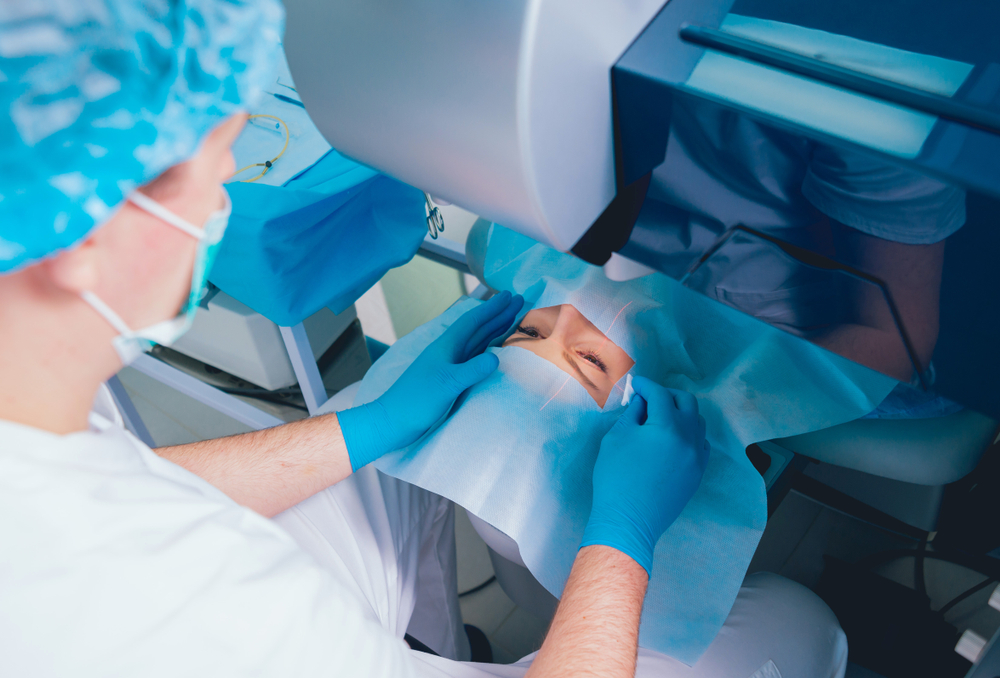Corneal Disease
What is the Cornea?
The cornea is a thin, clear, spherical layer of tissue on the surface of the eye that provides a window for light to pass through. In a healthy eye, the cornea bends or refracts light rays so they focus precisely on the retina in the back of the eye.
There are many diseases that can affect the cornea, causing pain or loss of vision. Disease, infection or injury can cause the cornea to swell (called “edema”) or degrade (become cloudy and reduce vision).

Common Cornea Diseases and Disorders
- Allergies
- Bullous Keratopathy
- Conjunctivitis (“Pink Eye”)
- Dry Eye
- Corneal Dystrophies including Fuchs’ Dystrophy and Lattice Dystrophy
- Glaucoma (High Eye Pressure)
- Infections
- Keratitis (Viral Inflammation)
- Keratoconus
- Ocular Herpes
- Pterygium
- Shingles (Herpes Zoster)
- Stevens-Johnson Syndrome
Corneal Disease Treatment
Treatment for corneal disease can take many forms, depending on the underlying problem as well as the patient’s preferences. Some conditions resolve on their own and many can be treated with medication. If the cornea is severely damaged or if there is a risk of blindness, a corneal transplant may be recommended to preserve vision.
Phototherapeutic Keratectomy (PTK)
PTK is a laser surgical procedure that removes roughness or cloudiness from the cornea. The cornea is the smooth clear window of the eye in front of the colored iris that helps bend light rays so they focus directly on the retina, the light-sensing layer of cells at the back of the eye. If the corneal surface is rough or cloudy, the rays of light do not focus properly on the retina and images are blurry.
Until recently, a rough cornea was scraped smooth with a surgical blade, while a cloudy cornea required a partial or full corneal transplant. More recently, phototherapeutic keratectomy, or PTK, is an option.
The excimer laser allows some abnormal corneas to be treated with a cool beam of light that evaporates tissue. The principal advantage of laser surgery over conventional surgery is that the laser is able to create a smoother corneal surface than a blade while smaller amounts of tissue can be removed.
Potential complications after PTK include poor wound healing, excessive corneal flattening resulting in farsightedness, and irregular astigmatism or poor vision that cannot be corrected completely with glasses.
CAIRS Procedure
The CAIRS procedure, short for Corneal Allogenic Intrastromal Ring Segment, is an innovative cornea procedure performed to improve vision in patients with keratoconus. This procedure involves implanting donor cornea tissue into channels surgically created in the cornea. The resulting change in the corneal shape can improve glasses-corrected vision and set the stage for further improvements. Georgia Eye Partners was the first practice in Georgia to offer CAIRS, and our corneal surgeons have been able to improve the lives of many patients through this procedure.
During the CAIRS procedure, a laser is used to create a channel in the mid-periphery of the cornea. The arc-shaped CAIRS donor tissue is then inserted into this tunnel. Recovery is fast, with most patients feeling fine and seeing some improvement even the day after surgery.
INTACS
INTACS are tiny, clear, plastic crescent-shaped rings that are implanted in the cornea to treat keratoconus. They help reshape the abnormal cone-shaped cornea found in those who have keratoconus. Georgia Eye Partners provided INTACS for about a decade before switching to the similar but newer procedure CAIRS for most cases.
Laser Scar Removal via PRK
This therapeutic treatment uses a laser to remove scars on the cornea. We have extensive experience with laser treatments for visual and cosmetic scar removal, and this approach can be used as an alternative to corneal transplantation.
Crosslinking
Crosslinking is a procedure that uses a combination of specially formulated Vitamin B eye drops and UV light to make the cornea four times stronger. This is very important for progressive keratoconus and post-surgical ectasia, conditions in which the cornea loses its proper shape and becomes thinner due to a weak spot. The result is a gradual loss of vision and increase in astigmatism.
We provide Glaukos iLink KXL crosslinking, the only crosslinking therapy which is FDA approved and the only one which is covered by insurance.
Crosslinking can stabilize the disease process and, in some cases, prevent the need for a cornea transplant in the future.

Lamellar Keratectomy
This corneal smoothing procedure involves peeling scar tissue such as Salzmann’s Nodules away from the cornea. This can improve vision as well as comfort. It is a fast, in-office procedure with rapid recovery.
EpiClear Superficial Keratectomy
Anterior basement membrane dystrophy (AMBD) causes blurred vision as well as can cause episodes of pain (recurrent erosions). This in-office treatment smooths the cornea and can correct both issues.
Penetrating Keratoplasty (PK)
PK is a full-thickness corneal transplant, meaning that your corneal surgeon will replace all five layers of the cornea with a donor cornea. This is the most common corneal transplant performed.
PK is typically for conditions affecting the entire thickness of the cornea, like keratoconus, infections, trauma, or scarring. Recovery takes many months, but PK is typically successful.
Pterygium Removal
A pterygium is a noncancerous growth of blood vessels and scar tissue that can distort vision, cause redness of the eye, and be a source of irritation. Removal is an outpatient surgical procedure which can improve vision and comfort.

Contoura Vision Topography Guided PRK
This treatment utilizes a 40,000 data point map of the corneal shape to program an excimer laser to reshape the cornea to a more ideal shape. We have more experience with this treatment modality than anyone in Georgia. It some cases it can be used in combination with crosslinking to improve vision in keratoconus. It is also used to account for previous traumas, scars, or complications from other surgical procedures.
Corneal Transplant
There are a few different types of corneal transplants performed depending on the layer of corneal tissue affected. If your eye doctor tells you that you need a corneal transplant, they will walk you through the different procedures and decide which is the best to treat your specific condition.
DMEK
DMEK, which is short for Descemet membrane endothelial keratoplasty, is a corneal transplant that replaces only the damaged innermost layers of the cornea, called Descemet’s membrane and endothelium. DMEK can be used to treat a variety of corneal conditions, most commonly Fuchs’ dystrophy.
During DMEK, the corneal surgeon carefully removes the affected endothelial layer of the cornea and replaces it with healthy donor tissue. After the procedure, you will likely be instructed to lie down on your back for a few days to weeks during your recovery to ensure the procedure is successful.
DSAEK
DSAEK, sometimes called DSEK and short for Descemet stripping endothelial keratoplasty, replaces the same layers as DMEK and includes replacing some of the stroma, which is another layer of the cornea.
DSAEK treats the same conditions as DMEK. The right procedure will vary from person to person based on a variety of factors, including which condition they may have and its severity.
The doctors of Georgia Eye Partners were some of the first in Georgia to offer DMEK, and they teach training courses for other surgeons on the technique. Georgia Eye Partners has participated in major national research studies as a clinical site, advancing the state of the at in the treatment of Fuchs’ dystrophy.
Are you experiencing symptoms of a corneal condition? Schedule an appointment at Georgia Eye Partners in Atlanta, GA, today!





